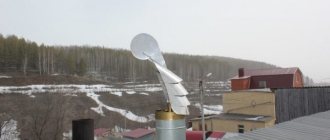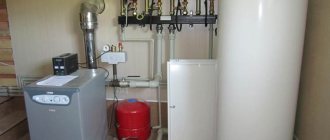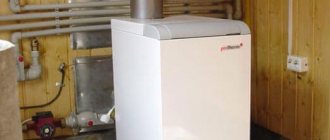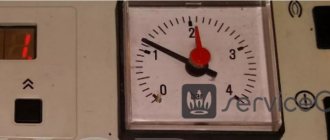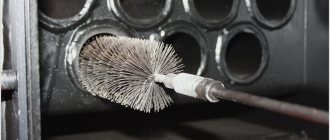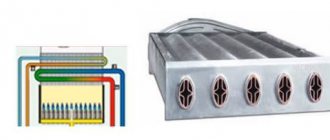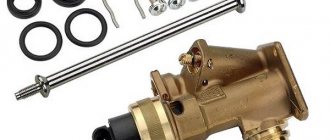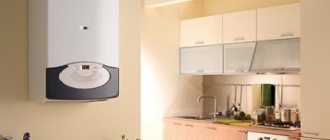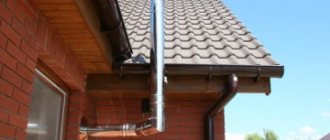Principle of operation
The operating principle of any chimney is based on a simple law of physics - warm air and vapors are always lighter and tend to rise, while cold air is heavier and, accordingly, settles below.
Due to the difference in temperature between the street (outside the pipe) and hot gases (inside the system), draft appears. Thanks to it, combustion products do not disperse throughout the room, but escape into the atmosphere.
Requirements for chimneys and installation rules
Installation of a chimney and ventilation for a gas boiler occurs in compliance with the chimney installation standards SNiP 2.04.05, and the manufacturer’s recommendations are taken into account:
- The size of the channel is chosen to be the same as that of the boiler socket or slightly larger. The height of the pipe is at least 5 meters.
- In rooms with traditional hoods, the exhaust air is replaced by air coming from the street and partly from other adjacent rooms.
- The chimney is made of non-combustible material.
Important! It is prohibited to use the ventilation duct to exhaust smoke.
After putting a gas boiler or other equipment with a chimney into operation, a chimney inspection report is drawn up.
Requirements for chimneys for gas boilers
Design, assembly, installation and other activities aimed at installing a smoke duct are regulated by regulatory documents that clearly and clearly state the basic requirements for these structures.
Regulatory documents regulating the installation of chimneys for gas boilers include SNiP 2.04.05–91 “Heating, ventilation and air conditioning”, as well as DBN V.2.5–20–2001 “Internal gas supply arrangement”.
For floor-mounted and wall-mounted gas boilers, a steel chimney is most often installed.
Based on these documents, the following requirements are imposed on smoke exhaust structures that will be used in conjunction with heating boilers:
- the cross-section of the chimney cannot be smaller than the outlet pipe of the gas boiler. For example, if the pipe has a cross-section of Ø150 mm, then the minimum diameter of the chimney must also be at least 150 mm. Along the entire length of the chimney, the pipe should not have narrowed sections or bends;
- location of the smoke duct - the chimney should go straight up. If necessary, a slope of 30° is possible. In this case, the length of the bends can be no more than 100 cm, and their maximum number - no more than 3. If a pipe rotation is required, then the radius of curvature must be greater than or equal to the diameter of the pipe used;
- the height of the chimney above the ridge is at least 0.5 m in cases where the pipe is located at a distance of up to 1.5 m from the roof ridge. If this distance is from 1.5 to 3 m, then it is permissible to install the pipe flush with the level of the ridge. In other cases, a conditional line is drawn from the ridge level at an angle of 10°. The pipe head should “touch” this line. The distance from the roof overhang to the chimney is at least 1.5 m;
The over-roof part of the chimney must have a certain height depending on the distance to the ridge - materials - only non-flammable, gas-tight materials are used for the manufacture of the chimney. When extending the structure, the upper part of the pipe must be placed on the lower link. In this case, the contact area must be treated with a non-flammable sealant;
- device - the minimum distance from the chimney to objects and surfaces made of flammable materials must be at least 25 cm. In other cases - at least 5 cm. When the chimney passes through the ceilings and roof, there should be no direct contact of the chimney with these structures . An inspection module with a drip pan must be installed at the bottom of the chimney.
The above requirements are general and must be met in all cases without exception. When installing a chimney, you should remember that even small deviations from the values required by regulatory documents can cause a decrease in the service life of the chimney, and in some cases lead to more serious consequences.
Chimney for gas boilers according to SNiP
In all buildings, it is allowed to connect no more than two heating furnaces or water heaters to one smoke duct, which are located on the same or possibly different floors of the house. But in this case, a distance of half a meter from each other must be maintained - at different levels of the floors of the house, or at the same level - a cut of 0.5 meters high.
Compliance with the cross-section of the chimney duct is also an important point at the design stage of the chimney itself. The circumference of the chimney pipe must be no smaller than the circumference of the gas boiler pipe. The cross-section of the chimney when connecting two devices to it must be calculated taking into account their simultaneous operation.
If you decide to install a brick chimney, then you should adhere to DBN-V.2.5-20-2001-“Gas supply” and use: frost-resistant brick (Mrz125) or clay brick, as well as heat-resistant concrete in high-rise buildings, and asbestos pipes in small buildings . It is known that today gas boilers have high efficiency - even perhaps 95%. At the same time, the temperature of the processed combustion products at the outlet is very low, resulting in the formation of a lot of condensate. In turn, the resulting condensate, or rather its chemical composition, destroys the brick chimney. Based on the above, a brick chimney must be lined/lined.
When a single-layer pipe made of stainless, acid-resistant steel is installed in a brick chimney, the process is called chimney duct lining. Thanks to this method of installing a chimney, the process of heating the chimney duct occurs much faster in relation to the condensate temperature. When gas is burned, harmful condensate and an acidic environment are formed, and this chimney design helps protect against their negative effects.
If your chimney duct has non-standard dimensions or may simply be crooked for some reason, then you can resort to lining the duct, i.e. use a flexible hose.
The best shape for any chimney duct is a cylinder shape. In second place is the oval shape of the pipe, then the square shape. Because Since combustion products and smoke produced by a gas boiler rise up into the chimney in a spiral, it is better to use a cylindrical pipe. If you use a square-shaped pipe, then dirt will accumulate in the corners of the pipe and the quality of traction will deteriorate.
Types and designs
There are several types of chimneys for gas boilers:
- Brick (both as a separate system and with an internal liner made of stainless or galvanized pipe);
- Single metal (made of galvanized or stainless steel sheet);
- Made of sandwich elements (channels of two metal pipes inserted into one another, with insulation laid between them);
- Coaxial (a pipe of a smaller diameter is inserted into a pipe of a larger one, without laying insulation);
- Ceramic (made from special ceramic blocks);
- Asbestos-cement.
All designs are schematically presented in the figures in the “Drawings and Schemes” section.
The chimney can be installed both indoors and outdoors.
Rice. 1. Design of attached and internal chimneys.
Chimneys for gas boilers made of stainless steel
Chimneys made of steel can have a single-walled or double-walled design. Single-layer exhaust pipes can be installed in heated rooms and used for lining brick chimneys. In three-layer systems, there is a heat-insulating layer between the two pipes, which makes it possible to use them for both internal and external installation.
Due to the fact that gas fuel contains sulfur impurities, when exhaust products are removed, its vapors have an aggressive effect, corroding the walls of the smoke exhaust channels. Therefore, in the production of stainless steel chimneys for gas boilers, heat-resistant and acid-resistant material AISI 316L is used. Its use greatly increases the service life of smoke exhaust systems.
Stainless steel chimneys have many advantages, including low weight, resistance to fire and aggressive chemical influences.
One of the weak points of a stainless chimney pipe for a gas boiler is its not entirely aesthetic appearance. The benefits include:
- resistance to corrosion and aggressive chemical composition;
- light weight, no need for a foundation;
- non-flammability of the material - stainless steel does not melt even at a temperature of 500 ºС;
- modular design - factory production of a large number of tees, adapters and elbows allows you to integrate a chimney into any home;
- factory production of all elements of the steel chimney allows it to be assembled and removed at any convenient angle;
- absolutely smooth round inner surface - provides a minimum of obstacles to the exit of combustion products;
- possibility of installation in an already built house;
- Quite affordable price of a chimney for a gas boiler.
When installing an external chimney made of steel, there is a high probability of dew point formation: if the temperature outside is low, the exhaust vapors form condensation and a water plug is created. It clogs the channel, preventing products from escaping, and thereby blocks the combustion process. This can be avoided by placing the pipe in a brick-lined chimney duct. This technique will also solve the aesthetic side of the structure.
Stainless steel chimney designs are easy to maintain
Another option to avoid the formation of a water plug is to use a sandwich structure of two pipes, one of which is protected by a layer of basalt wool. Such a remote chimney system no longer requires additional insulation. The diameter of the chimney for a gas boiler is selected so that it coincides with the cross-section of the equipment outlet.
Helpful advice! Stainless steel chimneys are easy to maintain, but it is necessary to have the system inspected by a specialist once every 3 years.
Which one is better to choose?
When choosing a smoke exhaust duct, you need to focus on the optimal combination of budget, gas boiler power, type of fuel combustion chamber and general design features of the building.
The installation of an external chimney saves internal space and is safer for the residents of the house, but such systems are susceptible to environmental influences, so their service life is shorter.
Types of chimneys depending on the type of gas combustion chamber:
- Open chamber boilers
Floor-standing gas boilers are often made with an open firebox. Such devices require a chimney that provides consistently good draft. Brick, ceramic, single and sandwich pipe chimneys are suitable. But it should be remembered that a brick chimney is hygroscopic and difficult to install, while a ceramic chimney is very heavy.
- Boilers with a closed combustion chamber
In this case, most craftsmen recommend installing a coaxial chimney, or a system of sandwich pipes, tees and fittings.
Coaxial chimneys.
Such chimneys are the most popular for wall-mounted boilers. They combine 2 pipes - one for removing exhaust gases, and the other for supplying air to the boiler. It is possible to use such a “pipe” only if the boiler has a closed combustion chamber. Their length is limited to four or five meters. If the length is longer, the boiler will not have enough air and will shut down or not operate optimally.
Various ways to install a coaxial chimney.
I took these recommendations from the passport of the Baxi Eco Four boiler. All other boilers may have their own nuances and before installation you must read the instructions. All possible installation options are shown in the figure below.
All possible installation options
The figure shows that there are 3 different options for coaxial chimneys:
- Diversion through the wall (the simplest option)
- Output to the central chimney type LAS
- Vertical chimney with outlet through the roof
The rest of the drawings are for separate chimneys, and we’ll talk about them a little later.
During installation, it must be taken into account that various bends (most often at 90° and 45°) reduce the possible length of the coaxial smoke exhaust system. This is due to the fact that they create additional resistance to exhaust gases:
- A 90° bend shortens the chimney by 0.5 meters.
- A 45° bend shortens the chimney by 0.25 meters.
The first outlet, which is located at the outlet of the boiler, is not taken into account. For a better understanding, let's use the picture again:
Length of various coaxial chimney options
It is clear from the figure that if you need maximum length, then the number of corners must be reduced to a minimum. Now let’s look at the LAS system, everything is absolutely the same:
LAS chimney system
Such a system is quite exotic, but has every right to exist. I think it will be especially convenient for apartment buildings heated with natural gas.
Now let's look at a vertical chimney for a gas boiler. Let's look at the picture again:
Vertical coaxial chimney for a gas boiler
The figure does not show a condensate collection device, which must be installed. Otherwise, the burner will be flooded with condensate and the boiler will turn off.
Make it yourself or order it
Order a chimney from professionals or do it yourself – it’s up to you.
Proper independent installation of a smoke exhaust system will definitely save the family budget. When installing, be sure to comply with all requirements of SNiP and fire regulations.
Despite the fact that the temperature of the exhaust gases is low, the harm from them is no less than from any other emissions. Therefore, special attention should be paid to the tightness of joints.
It is also mandatory to organize a condensate collection system.
Building regulations
All chimneys must comply with SNiP 2.04.05-91, DNP V 2.5-20-2001, SNiP 42-01-2002, as well as SP 7.13130. Under no circumstances should you use products that have not passed certification.
Basic fire safety requirements for chimneys:
- The cross-section of the chimney should be selected according to the power of the boiler;
- Deviations of the pipe from the vertical by more than 30 degrees are not allowed;
- The thickness of the walls of the chimney duct is at least 6 cm for heat-resistant concrete, at least 12 cm for brick and is not standardized for sandwich and asbestos cement;
- The length of the branch (horizontal section) of the chimney should not exceed 1 m:
- The minimum distance between the pipe and walls made of combustible materials is 250mm, and those of non-combustible materials are 50mm. Where the pipe passes through walls and partitions, it is necessary to install high-quality thermal insulation;
- The diameter of the chimney duct is selected equal to or greater than the boiler outlet;
- The air in the system should move at a speed of 15-20m/s;
- The distance from the hot surface of the channel to the wooden floor elements should be more than 13 cm for concrete, brick and sandwich and 25 cm for a pipeline made of ceramics or asbestos cement;
- At the base of the chimney it is necessary to organize a pipe to remove condensate;
Traction Requirements:
- The chimney for gas boilers should not be lower than 3 m in height (5 m recommended);
- Pipe height above roof:
- flat roof - up to 500mm;
- level with the ridge when removed from it by 1.5-3m;
- at the level of an imaginary line drawn from the ridge at an angle of 10 degrees to the pipe, with a distance between the pipe and the ridge of more than 3 m;
- The permissible radius of curvature of pipes in the system is equal to the diameter of the product;
- It is necessary to arrange pockets for cleaning (revisions);
- The chimney should not have narrowings or bends.
It should be taken into account that the smoke exhaust system should not contain more than three turns. Otherwise, traction decreases sharply.
You already know about the consequences of poor traction.
Requirements for chimneys according to SNIP
- The chimney for a gas boiler, according to SNiP, must be vertical. The slope of the chimney is allowed by 30 degrees and with a side deviation of 1 m, while it is necessary to observe the cross-sectional area of the inclined sections of the chimney (it must be no less than the cross-section of the vertical sections).
- The part of the pipe that connects the gas boiler to the chimney must be fixed only vertically. The length of this part of the pipe should be more than half a meter (if you count from the bottom of the smoke exhaust pipe of the gas boiler to the horizontal section of the axis).
- If the ceiling height in the room is up to 2.7 m, then for gas boilers with draft stabilizers, it is permissible to reduce the length of the vertical part of the pipe to 0.25 m, if there is no draft stabilizer - to 0.15 m.
- In new houses, the total length (total) of the horizontal connecting parts of the chimney pipe should be no more than 3 m, and in existing houses - no more than 6 m.
- To the gas side. device, the pipe inclination should be 0.01 degrees, no less.
- No more than 3 turns on chimney pipes are allowed, and the bend itself must have a radius of curvature no less than the diameter of the pipe.
- Below the connection point of the pipe from the gas boiler to the chimney there should be a condensate collector and inspection.
- The distance from the connecting section of the pipe to the ceiling (or wall) made of non-combustible material is allowed to be no less than 5 cm. When using flammable materials - no less than 25 cm. It is possible to reduce the distance from 25 to 10 cm, but only with the use of protection (steel + asbestos, at least 3 mm thick). Thermal insulation must extend beyond the dimensions of the connection. pipes 15cm on each side.
- The possibility of sagging fastenings of connecting pipes and suspension must be excluded. Each link of the chimney connecting pipes must be tightly connected to each other, without gaps. The links must fit into one another in the direction of the flue gases - no less than ½ (half) of the smoke diameter. pipes. It is also necessary to install a tight connecting pipe to the smoke duct. To ensure that the end of the pipe does not protrude beyond the channel wall, limiters are used - a corrugation or a washer.
- If you connect several devices at once that do not have draft stabilizers to a common chimney, then the chimney pipes must have dampers (their opening diameter is at least 15 mm).
- In the dampers that are installed on chimneys there is gas. boilers, the holes must be at least 50mm (in diameter).
- The free and complete release of waste combustion products into the surrounding atmosphere is important.
- Each heating device must have its own separate chimney.
- In order to clean exhaust gases, recesses with a depth of 250 mm must be placed in the chimney channels.
SNiP provides the following parameters for the height of the chimney for a gas boiler:
The height of the chimney pipes of a gas boiler relative to the roofs should be:
- not less than 500 mm above the roof ridge or parapet - if the pipes are located at a distance of up to 1.5 m from this ridge, parapet;
- not lower than the ridge/parapet - if the chimney is located at a distance of 1.5-3 m from the parapet/ridge;
- not below the border, which is drawn from the ridge down at a 10° angle to the horizon - when placing a chimney from the ridge of the roof or parapet, more than 3 m;
- at least 1200mm above a flat roof.
In any case, the height of the chimney above the touching part of the roof (adjacent) should be no less than half a meter, and for buildings where the roof is combined (flat) no less than 2 m.
Installation on chimneys for gas water heaters/boilers, umbrellas and other nozzles is not permissible (the only exception would be CONE, since it is considered a transition from a thermal pipe to a single-wall pipe).
Chimneys in the walls and ventilation ducts are allowed to be combined. But it is necessary to maintain their separation along the entire height with special fences, the thickness of which must be at least 120 mm. The height of exhaust ventilation ducts located close to chimneys must be taken equal to the height of the chimneys themselves.
The removal of waste combustion products is permitted through steel chimney pipes from: industrial enterprises that use gas appliances, as well as from boiler houses, housing and communal services. It is permitted: the release of combustion products into the atmosphere through the external walls of gasified premises without a vertical channel from heating and gas equipment with a sealed combustion chamber. Let us allow the combustion product to be removed through the roof of the building into a vertical smoke channel.
The length of the horizontal section of the smoke duct from the heating device with a sealed combustion chamber when it passes through the external walls is taken to be no more than 3 m.
Where to place the chimney
How the process of installing a chimney for a gas boiler will take place largely depends on where this mechanism will be located. Therefore, the moment of choosing a place for it should be approached with special care.
A chimney for a residential building can be located in several places:
Outside the house.
The features of such installation will be as follows:
- the entire length of the pipe must be equipped with thermal insulation;
- the structure is always accessible for dismantling and any repair work;
- no need to select different types of parts for the entire structure;
- high safety score.
Inside a residential building.
This installation is distinguished by the following points:
- It is necessary to insulate only that part of the chimney that is located outside the room, that is, on the street;
- more complex installation and repair process;
- potential risk of harmful substances generated during fuel combustion entering the house;
- the need to purchase different types of parts for pipe installation.
Chimney for a gas boiler in a private house: basic requirements of SNiP 2.04.05-91
Measures for installing a chimney for a gas boiler, from the design stage to the actual installation of the system, must comply with the requirements of the current regulatory framework, since improper installation and operation of gas equipment calls into question the safety of people using gas installations.
Main elements of the chimney design:
- flue - a channel leaving the boiler into the chimney pipe, connected by an adapter;
- chimney pipes;
- revision - attached to the bottom of the smoke exhaust shaft and serves to clean the channel from combustion products and remove excess moisture;
- fastening elements (brackets, clamps) - used for fastening to the wall;
- other components for the system device.
Requirements for the chimney when installing a gas boiler
As a rule, the location of a gas boiler in a private house is planned on the ground floor in a separate room (boiler room). All elements of the heating system must be connected to each other strictly tightly. The basic rules for installing chimneys for gas boilers, regulating the technological order, are presented in regulations SNiP 2.04.05-91 and contain the following requirements:
- proper draft - ensures complete removal of exhaust gases;
- resistance to high temperatures;
- tightness of connecting points - all components along the entire length of the chimney exhaust system must fit tightly to each other;
- the pipe where it passes through the ceiling must be solid, without joints;
- condensate collector - the design of this element must ensure the collection and removal of liquid;
- if the structure has turns, inspection hatches are installed in these places to diagnose the condition of the chimney, clean it and drain condensate;
- the length of the pipe branch to the side should not exceed 1 m;
- the permissible number of turns on chimney pipes is possible - no more than 3;
- the height of the chimney pipe must exceed the height of the roof (at the highest point) to ensure good draft and prevent reverse draft;
- the distance between the chimney pipes and the surface, which is made of non-combustible materials, can be at least 5 cm, and if the surface material is flammable - at least 25 cm.
Gas boiler chimney outlet options
Helpful advice! Complete sealing of the chimney sections will not allow hot combustion products to escape the system.
What material
A chimney for a gas boiler in a private house can be made from different materials. The main requirement is resistance to chemically aggressive substances, inability to pass gases. Traditionally, several materials are used. Let's talk in more detail about the advantages and disadvantages, as well as the assembly features of each of them.
Brick chimney
Today this is no longer the most popular type of chimney. It turns out to be heavy and requires a foundation at high altitudes. In addition, laying a brick chimney takes a lot of time.
However, this type of chimney has a number of negative qualities. First, its inner walls are not smooth, which contributes to the accumulation of soot and impairs traction. Secondly, brick is hygroscopic. Therefore, the condensate flowing down the walls is absorbed, which contributes to rapid destruction.
Construction of a brick chimney for a gas boiler with a metal sleeve insert
To solve these problems, a smooth pipe of suitable diameter is inserted inside the brick chimney. This is usually a stainless steel or asbestos pipe. When building such a combined chimney, attention must be paid to the following things:
- The joints of the liner pipe must be made airtight. If these are ordinary or sandwich pipes made of stainless steel, everything happens as standard - we collect the chimney using condensate. If the liner is made of asbestos-cement pipes, you will have to take care of the tightness of the joints. Moreover, covering the joint with cement is not an option. Such a connection is not sealed in any way - condensation will be absorbed. We will have to come up with sealed clamps and use hydrophobic (water-repellent) compounds. Moreover, they must also be chemically resistant. As an option, you can consider coating the joints with heat-resistant sealants with an operating temperature of about 200°C.
- To ensure that condensation forms as little as possible, it is better to insulate the pipes (even inside a brick casing). To do this, it is advisable to use insulation that is not afraid of getting wet.
- A condensate collector must be attached to the liner pipe below. Access to it must be free.
If you make a chimney for a gas boiler according to these rules, then even with abundant condensation it will be easy to deal with.
Stainless steel - single wall pipes and sandwich
Modern gas boilers are designed so that the temperature of the flue gases at the outlet is not very high. Therefore, condensation always forms. With good draft, most of it flies into the pipe; with good insulation, the remaining part evaporates. So it turns out that liquid is not always present in the condensate collector. But condensate itself is formed when the gas boiler is running all the time. Sometimes in larger quantities, sometimes in smaller quantities. In this regard, the requirements for stainless steel for a chimney are high: it must withstand prolonged contact with caustic substances. These requirements are mainly met by food grade stainless steel. Yes, it costs a lot, but only it will serve for years.
Sandwich pipe structure
Now let’s talk about whether to make a chimney for a gas boiler from a single-wall pipe or from sandwich pipes. In order for condensation to form in minimal quantities, it is desirable that the chimney does not cool down. That is, it needs to be insulated. And although the sandwich chimney has a lining made of insulation, when laying it externally (on the street) it is also better to insulate it - it will last longer, the draft will be better. But in this option, less insulation will be required - one layer, whereas a regular pipe may have to be wrapped in two or even three layers. So the costs of installing a chimney from a single-wall stainless pipe and sandwiches will be comparable. It’s just that in the first case you will have to use more insulation, and in the second less.
Location of pipes of a combined chimney and column
In some cases, two devices are connected to one chimney at once. This is allowed by building code documents: it states that up to two heating or gas devices can be connected to one chimney, provided that there is no coaxial electric cable nearby. The main thing is that the chimney is not personal, since independent installation of vertical chimneys from the chimney is prohibited.
Location of pipes of a combined chimney and column
And if this is done after receiving permission from the housing department, then the chimney outlet must be placed at a great distance from the ventilation grille and must be lower than it. In this case, combustion waste does not enter the ventilation hole and pollute the air.
Before moving on to the rules for the internal structure of the column and chimney, you also need to clarify the general rules.
The chimney is installed:
- optimally - on a blank wall, if the house has one;
- in the absence of a blank wall - at a height of 2 meters from ground level;
- at a distance of at least 0.5 m from ventilation, door and window openings;
- at a height of at least 1 m from the window opening (down);
- at a height of at least 0.5 m above the window or doorway of the house.
If these standards are observed, you can proceed directly to the internal device. No more than two pipes from different devices can come out inside one smoke exhaust channel, as can be seen from the photo. In the case of the removal of gas combustion products, a distance of 75 cm should be made between the pipes. This is the minimum distance value that avoids complex explosion or heating. The normal location can be seen in the photo.
Installation of a chimney
Gas pipes inside the dispenser are also subject to regulations. If a box is created to supply gas and remove the combustion product, or a column is purchased where all transporting gas pipes are already pre-installed, you need to take into account the internal distance between the elements. So, from one pipe to another there should be at least 400 mm, that is, 40 cm.
It is also important to clarify the joint installation of the chimney, water heater and individual gas pipes. The distance between the gas pipe and the chimney must be at least 80 m vertically, and a minimum of 50 cm is always maintained between the gas water heater and the gas pipe.
Please note: If you are concerned about possible regulation changes, have forgotten some numbers, or are simply unsure of the information above and below, contact your local housing authority or gas company. Over the phone or during a personal visit, employees will be ready to provide the necessary installation information about the distances between pipes, as well as how to fully equip a new house with gas equipment.
Installing a sandwich chimney
The first stage of installing an attached structure is punching a hole in the outer wall and preparing for laying a horizontal section. In a house built from combustible materials, the opening is made taking into account the fire safety clearance (38 cm from the edge of the wooden wall to the inner pipe of the sandwich) and the installation of the flange of the passage unit, as shown in the photo.
Note. In fireproof structures made of bricks and foam blocks, a fireproof cutting device is not required. A metal sleeve is placed into the opening and a section of the flue is inserted, sealing the gap with non-flammable material.
Work on installing the modular sandwich and connecting to the gas boiler is carried out in the following sequence:
- Assemble the lower part of the attached chimney, including 2 tees and a condensate drain section. Attach the horizontal section going into the hole.
- Try the assembly on the wall and determine the location for mounting the support pad. Secure it and install the lower part, leading the pipe into the wall. Maintain verticality, controlling the position of the unit with a building level.
- Having fixed the lower part of the flue, mount the vertical section. Connect the straight sections in such a way that the upper shell fits onto the lower one, and the flue pipe, on the contrary, is inserted inside (condensate assembly).
- Fasten the wall chimney duct at intervals of no more than 2.5 m. The brackets should not fall on the joints of the sections.
- Lay the horizontal section of the sandwich up to the gas boiler and put on the adapter. Secure the chimney with clamps to building structures with a maximum spacing of 1.5 m.
- Connect the heat generator to the chimney with a piece of single-wall stainless pipe.
Watch this video on YouTube
Reminder. In a wooden house, seal the gap between the ends of the wall and the intersecting pipe with basalt fiber, and then install metal flanges on both sides.
Straight sections are simply inserted into each other and secured with clamps; there is no need to coat the joints with sealants. If trimming is necessary, then the lower end of the section is shortened, where the insulation is located flush with the metal linings. A protective cone is placed on the upper edge of the chimney.
Detailing for internal installation
Laying a smoke exhaust duct inside a building is done in the same way, only you will have to go through the structure twice, or even three times. The same rules for constructing cuttings when crossing flammable floors and walls are observed everywhere. At the end, you need to carefully seal the roof where the pipe passes, as is done in the video:
Watch this video on YouTube
Requirements for installing a chimney
Installation work is carried out by specialists using all regulatory rules. They are as follows:
- Every heating unit has a single chimney outlet.
- Free and complete exhaust of smoke into the atmosphere is ensured due to the correctly selected height and cross-sectional size of the pipe (clause 5.1.1.VDPO).
- The wall thickness of the metal pipe is not allowed less than 2 mm.
To make a pipe, metal with a thickness of 2 mm or more is taken Source pech-kamin.ru
- To clean smoke channels from soot, recesses with a size of about 250 mm are provided (clause 3.74 of SNiP-91 and clause 5.1.1.VDPO).
- When installing a pipe, the smoke channels are made taking into account no more than three turns, and their rounding is equal to the diameter of the pipe (4.2.17.VDPO).
- The chimney for a gas boiler in a private house and the exhaust pipe are installed above the roof ridge in accordance with clause 3.73.SNiP-91: up to 0.5 m - with a flat roof; at the level and above the roof itself - when the pipe is located more than 1.5 meters from the roof ridge.
Metal chimneys are made of high-quality alloy steel with anti-corrosion coating.
Chimney made of galvanized pipe
Chimney device
The sandwich-type design made of pipes is rightfully considered one of the most effective and successful options for smoke exhaust devices.
Today, manufacturers offer a huge range of such chimneys. Among their advantages, it is necessary, first of all, to note their resistance to aggressive external influences and various mechanical loads.
The “sandwich” itself has an extremely simple structure. It consists of two pipes of different diameters, one of which is inserted into the other. To fill the gap between such pipes, non-flammable basalt wool is most often used.
Sandwich pipe for chimney
The principle of arranging a chimney for a wall-mounted gas boiler
Due to the fact that gas boilers can be not only floor-mounted, but also wall-mounted, there are also chimneys for wall-mounted gas boilers. Their design includes two pipes, one of which is inserted into the other, but there is no insulation on them. This type of chimney arrangement for a gas boiler allows combustion products to be safely removed, while at the same time allowing fresh air to enter. The minimum distance from the beginning of the pipe to its outlet is 2 m.
Some modern models of gas boilers are equipped with a special sealed combustion chamber of the energy source. The operating principle is configured so that installation of a chimney for a gas boiler is not required.
If all the above rules and recommendations are followed, the chimney system for a gas boiler will be safe and efficient.
If any difficulties arise with the assembly and installation of the structure, it is recommended to study various photos of chimney pipe options and their installation diagrams, and it would also be useful to seek help from specialists, since working with gas equipment is always associated with some risk. Video about the requirements for chimneys of gas boilers:
Coaxial chimney for gas boiler
Coaxial chimney Gas wall-mounted boiler
A modern option with excellent performance characteristics and a presentable design. Manufactured according to the “pipe-in-pipe” scheme. Designed for use with gas boilers whose combustion chamber is closed. In this kind of equipment, the air intake for gas combustion is taken from the street, and not from the heated room.
The principle of operation of a coaxial chimney
The air supply is carried out through an external pipe laid through the outer wall of the building. Smoke containing impurities is discharged through the inner pipe. Such a device is also advantageous in that it eliminates the need to install an additional ventilation system.
View of an installed coaxial chimney
In addition, the specific shape of the coaxial chimney eliminates the possibility of condensation forming on its walls, which is especially important in heating systems operating on gas fuel.
Standards and requirements for gas boiler chimneys
In our country, there are two regulatory documents establishing requirements for chimneys of gas boilers - DBN (V.2.5-20-2001) and SNiP (2.04.05-91). Compliance with these standards by installers is strictly mandatory. If you study the documents well, you can derive the following basic rules:
- The diameter of the chimney should not be less than the outlet pipe of the gas boiler. Inspection authorities can turn a blind eye to a couple of millimeters of difference, but we do not recommend tempting fate, as this can result in serious expenses.
- Sloping sections along the length of the chimney are allowed, but not more than 30 degrees, with the length of the section no greater than the height of the room. Ideally, the main part should be installed strictly vertically.
- The presence of curvatures of the chimney and narrowing along its entire length is not allowed. All this can lead to a deterioration in the passage of gases.
The chimney has a short horizontal section - Chimney parts can only be made from materials that do not allow gas to pass through.
- The joints of all parts of the structure must be carefully sealed to prevent leaks. Neither moisture nor gases should pass here.
- Modern boilers are designed in such a way that the exhaust gases at the outlet have a relatively low temperature, and this can lead to the formation of condensation inside the pipes. Therefore, the system assumes the presence of a condensate trap at the bottom. It is a removable glass made of material resistant to various chemicals - stainless steel or plastic. The first option is considered reliable.
- To ensure good draft, the chimney must be made of sufficient height. The minimum requirement is 50 cm above the roof ridge if it is located next to it.
- An umbrella-deflector is installed on top of the chimney outlet, which will improve draft and protect the pipe from precipitation getting inside.
Chimney for two boilers - the diameter of the pipe increases along the way
As you can see, the requirements are extremely simple and logical, and are aimed either at ensuring the required level of safety, or at organizing proper operation and improving traction. It is not difficult to comply with them if you select the right materials and carry out installation without deviating from the instructions.
Stainless steel chimney
How to reduce the temperature of flue gases in a chimney
The combustion of natural gas produces carbon dioxide, steam, sulfurous salt-forming oxides, etc. The optimal temperature of the flue gases at the chimney outlet should be 100–110 °C.
If the temperature of the flue gases is below the dew point, that is, the condensation temperature of the air, then the water vapor contained in the combustion products will settle on the walls of the chimney. If this happens constantly, the chimney can quickly collapse.
If the temperature of the flue gases is too low, condensation will form at the outlet of the chimney, and the outer part of the pipe will begin to freeze.
In addition, the presence of constant condensation in the smoke channel leads to a weakening of natural draft. Therefore, it is so important to monitor the temperature of the flue gases, which directly depends on the cross-section of the chimney.
From the above we can conclude that with correct calculation, the temperature of the flue gases will be in the region of optimal values. If the temperature is too high and needs to be reduced, this directly indicates that the cross-section of the chimney does not correspond to the power of the gas boiler. To reduce the temperature of the exhaust gases, it is recommended to reassemble the smoke exhaust system taking into account the standard values.
Installation of a gas wall-mounted boiler - kitchen requirements
- Ceiling - 2 meters and above.
- The total volume of the kitchen is more than 7.5 m3, ventilation is equipped, a window is installed and there is a door opening onto the balcony.
- For air exchange, it is necessary to install a grille at the bottom of the wall or door that opens into the next room; the area of the grille is at least 0.02 m2.
To install a gas boiler in the kitchen, you may need permission from the gas service.
If the kitchen in the apartment does not meet the requirements of SNiP, then gas heating equipment can be installed and operated only with the permission of the gas supervision authority.
Attention!
It is strictly forbidden to install more than 2 heating devices or more than 2 boilers in one room if the volume of the room is less than 7.5 m3
The existing rules for installing a gas boiler in a private house largely repeat the requirements for boilers that operate in apartments in multi-storey buildings. The differences are caused only by the fact that often in a private house a separate room or building is allocated for heating equipment, which is subject to additional requirements listed below.
How to check and adjust the draft in the chimney of a gas boiler
Draft is a decrease in pressure in the place where fuel combustion occurs. The pressure decrease occurs due to the removal of combustion products through the smoke channel. Speaking within the framework of this article, draft forces fresh air into the combustion chamber, where there is a reduced pressure that occurs due to the fact that gas combustion products are discharged outside.
The presence of draft indicates that the chimney is designed and installed correctly, and the equipment is working properly. The lack of draft may be a direct or indirect confirmation of the need for preventive maintenance or repair of equipment and the chimney system.
The speed of air flow in the chimney can be measured with a special device - an anemometer
The following methods are used to check the draft level:
- visual inspection - there should be no smoke in the room where the heating equipment is located;
- using improvised means, for example, a sheet of paper. It is brought to the inspection hole. If there is traction, then the sheet will deviate towards the hole;
- measurement with a special device - an anemometer. It is used to control air speed.
To control traction, it is better to use the latter method, since only it will show the exact value. When measuring natural draft, the flue gas velocity should be in the range of 6–10 m/s. The value is taken from SP 41–104–2000 “Design of autonomous heat supply sources.”
If it is necessary to reduce the draft level, then this will require reassembling the chimney based on a chimney of a larger cross-section. To increase traction, it is recommended to check the quality of the installation joints and mechanically clean the smoke channel using a steel cable with a brush attachment.
If this does not help, then the only way out is to replace the chimney with a preliminary calculation of the chimney cross-section. In this case, it is desirable to reduce the number of rotating elements to a minimum or remove them altogether.
Why does the boiler blow out and how to fix it
The main reason why the burner in a boiler blows out is the backdraft effect that occurs due to problems with the chimney.
Before starting any measures, you should check the height of the chimney above the ridge level and the presence of an installed deflector, which reduces the penetration of wind flows into the chimney. If the pipe installation is not carried out according to the rules, then after the steps described below, you will need to extend the pipe and install a deflector.
Sometimes, in order to increase draft, you need to clear the chimney of soot
In order to solve the problem with the boiler blowing out, you will need to do the following:
- First of all, you need to check the draft level in the pipe. It is better to use an anemometer. If you cannot find it, then with the boiler running you need to lean the paper against the outlet of the chimney. If the sheet is attracted to the chimney, then there should be no problems with draft.
- If you find that the blowing occurs due to a loss of natural draft, you will need to check the chimney joints. A thermal imager is used for this. If the pipe allows air to pass through, the device will show a strong temperature difference between the main pipe and the junction of the two modules.
- If the chimney is assembled correctly, then it is necessary to clean the smoke channel using a cable with a nozzle. The diameter of the nozzle is selected to match the cross-section of the chimney pipe. To remove soot, tar and other combustion products, an inspection hole is used at the bottom of the chimney.
- After completing these simple steps, you will need to check the traction level again. If natural draft has not improved, then it is necessary to carry out work to correct the height of the chimney and install a deflector. During installation, heat-resistant sealant and crimp clamps are used.
In cases where the work described above does not produce results, you should contact the gas service to check the gas equipment. Perhaps the problems with blowing are associated with hypersensitive automation.
